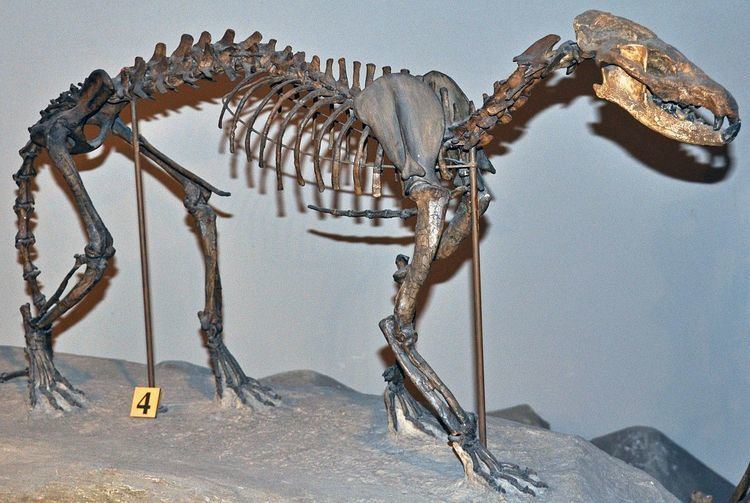Family †Amphicyonidae Rank Genus | Phylum Chordata Order Carnivores | |
 | ||
Similar Cynodictis, Carnivores, Cynodesmus, Daphoenodon, Mesocyon | ||
Daphoenus is an extinct genus of caniform carnivoran mammal of the family Amphicyonidae ("bear dogs") of the suborder Caniformia. Daphoenus inhabited North America from the Early Eocene subepoch to the Early Miocene subepoch 42—16.3 Mya, existing for approximately 25.7 million years.
Contents
Taxonomy
Daphoenus was named by Joseph Leidy (1853). Its type species was Daphoenus vetus. It was assigned to Amphicyonidae by Leidy (1853) and Carroll (1988); and to Daphoeninae by Hunt (1998) and Hunt (2002).
Amphicyonids are discussed in Robert M. Hunt's article Global Climate and the Evolution of Large Mammalian Carnivores during the Later Cenozoic in North America. D. Vetus was the largest of the species. D. hartshornianus, D. lambei (syn. D. demilo), D. ruber, D. socialis, D. transversus, D. vetus (syn. Proamphicyon nebrascensis)
Daphoenus hartshornianus was named by Cope (1873). It was recombined as Protemnocyon hartshornianus by Hatcher (1902); it was recombined as Daphoenus hartshornianus by Scott (1898), Sinclair (1924), Scott and Jepsen (1936), Galbreath (1953) and Hunt (1996). A single specimen was measured by Legendre and Roth in 1988 for estimated body mass. 6.79 kg (15 lb). Daphoenus hartshornianus fossils found in Oligocene Orellan rocks in the Lower Nodular Zone, Pennington County, South Dakota are dated at ~33.4 Ma. Other sites include the Prairie Dog Creek Site and Warbonnet Creek Site, Sioux County, Nebraska ~33.4 Ma., Bartlett High Site, Dawes County, Nebraska ~33.2 Ma., Babby Butte Site, Oglala Lakota County, South Dakota ~33.4 Ma—33.2 Ma.
Daphoenus lambei fossils found in Eocene Duchesnean rocks at the Big Red Horizon Site, Presidio County, Texas are dated at ~38.4—38.3 Ma. Other sites include the Badwater Locality 20 Site and Wood Locality Site, Natrona County, Wyoming ~41.8 Ma., Lac Pelletier Lower Fauna Site, Saskatchewan ~42.3 Ma. A single specimen was measured by Legendre and Roth in 1988 for estimated body mass. 4.84 kg (11 lb).
Paradaphoenus transversus was named by Wortman and Matthew (1899). Its type specimen is AMNH 6851, a maxilla (rostrum), and it is not a trace fossil. It was recombined as Daphoenus transversus by Hunt (1998).
Daphoenus ruber was named by Stock (1932). Its type locality is Tecuya Canyon, California. A single specimen was measured by Legendre and Roth in 1988 for estimated body mass. 5.94 kg (13 lb). Daphoenus ruber fossils were found in Oligocene Arikareean rocks in the Tecuya Canyon Formation of Kern County, California with other mammal species and are dated at ~29.8—24.8 Ma.
Daphoenus socialis was originally desinagnated as Pericyon socialis and named by Thorpe (1922) a genotype. It is the type species of Pericyon. It was recombined as Daphoenus socialis by Hunt in 1998. A single specimen was measured by Legendre and Roth in 1988 for estimated body mass. 13 kg (29 lb). Daphoenus socialis fossils found in Oligocene Hemingfordian rocks at the Haystack Member, Wheeler County, Oregon are dated at ~24.3 Ma. and Kimberly Member, Grant County, Oregon with several other species of mammal such as Hesperocyon, Hypertragulus, and Leptomeryx dating ~25.4—25.3 Ma.
Description
A single specimen was measured by Legendre and Roth in 1988 for estimated body mass.
Daphoenus, like the rest of its family, was called a "bear dog" because it had characteristics of both bears and dogs. These animals were about the size of the present day coyote. Daphoenus vetus was the largest species. The male skulls could reach up to 20 cm in length. Daphoenus had short legs, and could only make quick sprints; it was not capable of running long distances. It is thought that these animals ambushed their prey, and did some scavenging. Fossil footprints suggested that, like present-day bears, these animals walked in a flat-footed way. Daphoenus dug burrows for their offspring to stay in and hide from their prey.
Distribution
Daphoenus fossils found in late Oligocene rocks in the Great Plains are dated at ~28 Ma. Daphoenus survived to 27 Ma in the Pacific Northwest in the John Day beds of Oregon. Other sites include: Alachua County, Florida (Whitneyan) estimated at 31.1—24.3 Ma., Tecuya Canyon, California (Arikareean age) 30.8—20.6 Ma., Haystack Member Formation, Wheeler County, Oregon (Hemingfordian) 20.6—16.3 Ma., Lac Pelletier, Alberta, Canada (Duchesnean) ~42 Ma.
